
HealthTech Integrates 2024, hosted jointly at Level 39 by Kadans Science Partner and Canary Wharf Group, brought together innovators, investors, business leaders, industry partners and experts to explore the ecosystem of people, skills, funds and policy that are shaping the HealthTech sector.
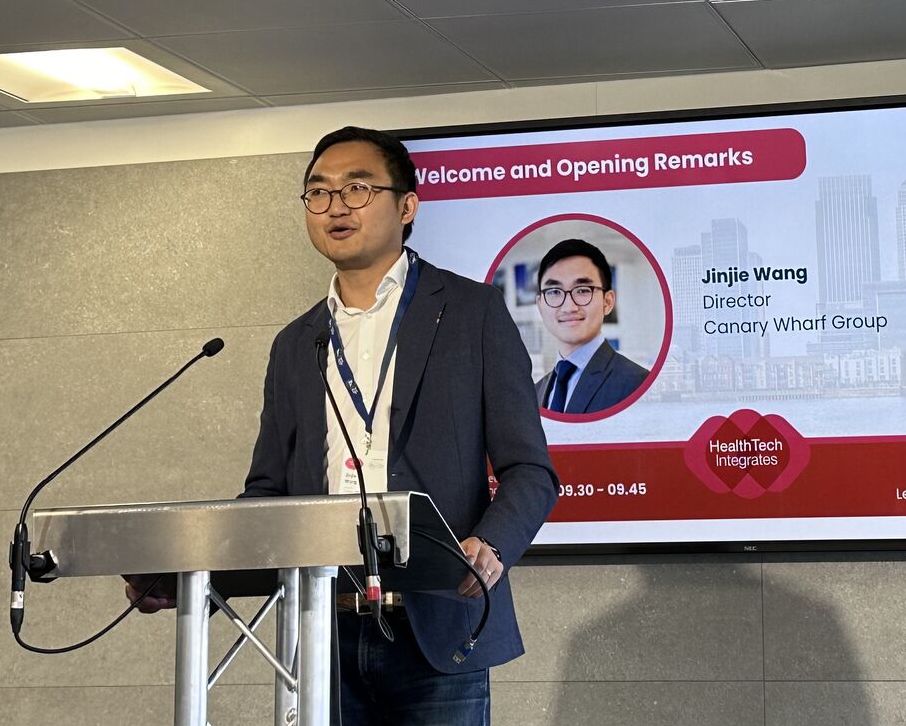
Jinjie Wang, Director of the Canary Wharf Group
The event was opened by Jinjie Wang, Director of the Canary Wharf Group, who began by telling a story about Sir George Iacobescu, former Chairman of the Canary Wharf Group who led the construction and development of Canary Wharf over the last thirty-five years into the success that it is today, despite initially not believing in the project. Jinjie spoke about the importance of believing your ideas and said, “you have to believe in yourself and keep fundraising”. He welcomed attendees to HealthTech Integrates and said “The key work is about growth and scale – the UK has great potential – loads of talent and great entrepreneurs. We, Canary Wharf Group with our partners Kadans Science Partner, want to help. We alone are not the answer to success and scale – we need to bring together the right partners, the innovators, the government regulators, the companies and the customers into one room”.
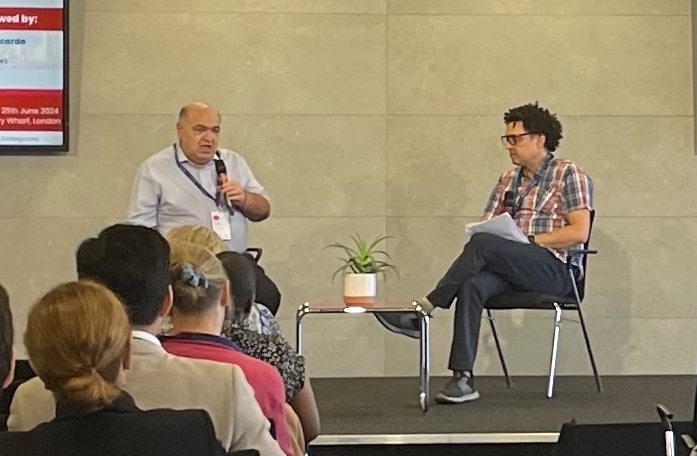
The fireside chat of the day featured Martin Carpenter, interviewed by Martino Picardo.
Martin, Chief Digital Transformation Officer at NHS Kent & Medway, began his career in accounting before moving into Financial and IT management which sparked his interest in delivering digital transformation projects. He described how working for non-profit led him to realising that there was more to life that making a profit which drove him to wanting to work in organisations that made a difference through social impact.
Asked about his definition of digital transformation, Martin said “It is about the people process and how the technology can enable transformation. If things are being done in an inefficient way you can use technology to do it differently and change that process”. On the difficulties of bringing digital transformation to the NHS, Martin described it as a “slow culture shift”. Comparing it to the digital transformation of gov.uk websites he said “It’s all about starting at the principals, with gov.uk there was one focus; to be user centred, however in the NHS there it is a bigger challenge to get people to come from the same place, the NHS is 1000s of organisations that are loosely coupled. Giving a successful example, he highlighted the Genomic’s England 100,000 Genomes project, as a scale up transformation that has worked well. “Part of this is that setting your own genome mapping service up was more expensive, so you needed to work at scale.”
Martin went on to discuss the work he does in Kent and why Kent is held up as a national exemplar for digital transformation. “You have to think of healthcare as a factory, which sounds depersonalised, but it is all about flow, matching supply and demand.”
Giving advice to those looking to introduce an innovation into the NHS he said, “you have to make sure you have the right product fit. Do you have a real-world problem that you haven’t invented yourself to fit your product. Make sure that you tick these three boxes: how will it help patients? How will it help the workforce, how does it bring down costs. This makes it an easy sell. If you struggle with one of these boxed it will be difficult for an NHS trust to get behind. Kent Medway is financially challenged – £50m deficit – this year more and most integrated care boards are in the same position.” He also reiterated that despite financial challenges that the process of procuring innovations for the NHS hasn’t stopped. “Innovation is key to move the NHS along”. Specifically Martin highlighted the need for innovations that don’t have a clinical benefit but improve efficiency and increase capacity for the back office. The fireside chat concluded with audience questions such as the role that clinical teams play in digital transformation and how to bring the general population along the journey of change. For both questions Martin gave his insights and said “the press can take on negative side and we in the UK are expert doom makers, we need to show the good – show positive case studies. Treat UK population as grown-ups” and “Teams have a huge amount to play, the people closest to the problem know the problem best.” To finish Martin was asked about the thing he’s most proud to have achieved in his time at Kent & Medway and he said “Culture – change of culture in the team. My team covers lots of different areas – All used to operate in complete silos and that doesn’t happen anymore. We understand each other’s issues, lean in and help each other.”

Nishan Sunthares, ABHI, John Terry, Neuronostics, Katrina Douglas, OXLABS and Cynthia Bullock, Innovate UK
The first panel of the day, The reinvention of prevention, chaired by Cynthia Bullock (Deputy Director – Healthy Ageing Challenge Innovate UK) began by panellists answering the question how do we engage in a proactive healthcare collaboration between the individual and the system? Cynthia started by saying “Understand the individual’s risk/benefit. Social contract that needs to happen. Recognising that it’s a multi stakeholder that needs to be talked about”.
John Terry, Managing Director of Neuronostics, followed with “It is really challenging. One of the challenges of diagnosis/medicalisation is we group everyone together. But the journey that individuals have been on to that diagnosis is very different and affects how they feel about the diagnosis and what they will do next. People will have very different attitudes on the steps they are willing to take”
Katrina Douglas, CEO of OXLABS agreed and said “It’s about communication and a shift in how we view healthcare, sometimes we abdicate responsibility to a healthcare professional, to get those messages across it starts with communication, trust and a better relationship”
Referring to the fireside chat, the panellists were then asked about what this means for innovators. Nishan Sunthares, Executive Director, Diagnostics at the ABHI said “Today we tend to be approaching it from affordability. In the election, a health system is measured on cost. And yet we know what prevention means for the individual. There is a piece here for setting out the vision for what prevention is.”
Cynthia agreed and said “It goes back to who benefit and who spends. Recognise that the old system doesn’t work for everyone, so we need to think about new models. We need the right frameworks to have the conversations and understand the human value/social benefit and ensure that it is felt by lots of different parts of the population.” She then asked about the role that diagnostics could play in prevention.
The panel all agreed that this was a difficult principal to determine, John asked “how do we define diagnosis. If we think about dementia, first time we think about it is when someone starts forgetting things beyond the usual side effects of ageing – this is usually too late. The Lancet published that only 50% risk is due to genetics and some is due to controllable lifestyle factors. Should there be ways in which we identify people at risk and help them to make the changes to reduce their risk? Exercise more, drinking less, going to outdoor places, people have some control but not complete control. How do we communicate personal risk vs overall population risk?
Katrina also responded by asking about the definition of diagnosis and said “I believe we can’t start too early. Even simple things like a Fitbit where the onus is on us, then social care and home monitoring, and then healthcare. If we can diagnose before it becomes a healthcare crisis it significantly decreases cost”
The panel questions concluded by asking the panellists what outcomes they would look at and what they feel would be key to achieve a proactive health system. On outcomes Katrina said “Patient satisfaction is one key measure. Reduction in terminal diagnosis by picking up data earlier. Expect that the average cost per patient should go down and that admittance levels should be lower and admitted for less time.”
To finish the panel took an audience question about the role of legislation to make it easier for people to make healthier choices. The consensus from panellists was that it is difficult to legislate lifestyle choices but it is key to address the issues holistically with input from multiple government departments and groups working together.
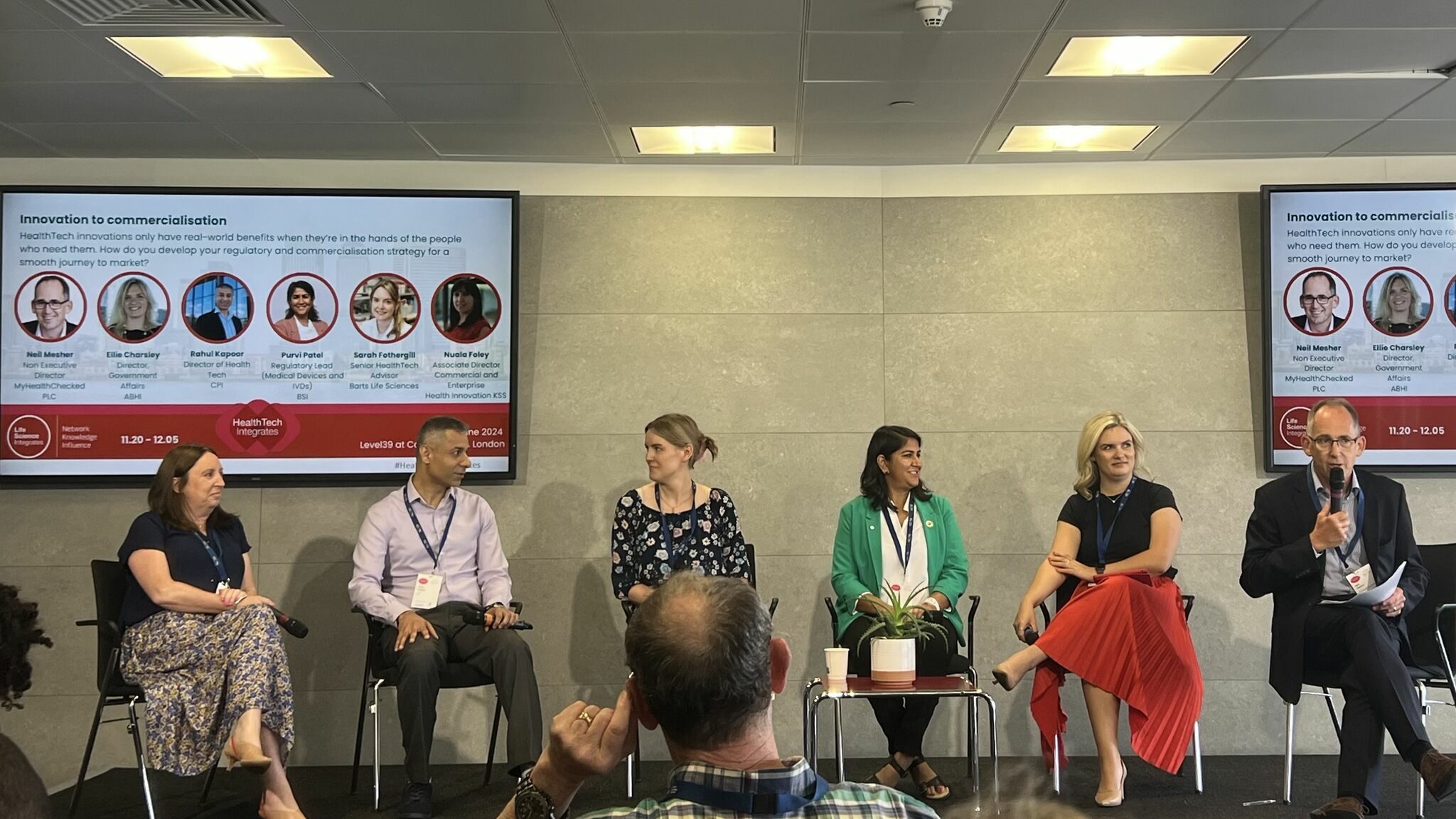
Nuala Foley, Health Innovation Kent Surrey Sussex, Rahul Kapoor, CPI, Sarah Fothergill, Barts Life Sciences HealthTech, Purvi Patel, BSI, Ellie Charsley, ABHI and Neil Mesher, MyHealthChecked PLC
The Innovation to commercialisation panel, chaired by Neil Mesher, Non-Executive Director of MyHealthChecked PLC, focused on the challenges of developing a regulatory and commercialisation strategy to take an innovation to market. Neil began the panel by asking the panellists to introduce themselves and to talk about their experiences, particularly advice for innovators looking to get through regulatory approval and access the NHS.
Sarah Fothergill, Senior HealthTech Advisor at Barts Life Sciences HealthTech, began by encouraging innovators to understand the problems that need to be solved and to reflect on their own offering. “Evidence is key, this takes many forms but be honest about what you have and the limitations of this”.
She added “Involve the community. Develop something that has diverse inclusive perspectives that reflect the community. Have patience. Navigating the procurement landscape is difficult but have persistence and resilience on the way.”
Nuala Foley, Associate Director Commercial and Enterprise at Health Innovation Kent Surrey Sussex, spoke from her experience in supporting health tech innovators through their routed into the NHS. She said “what do poor innovators do? What stands out the most are innovators who are fixated on the features of the product but not looking at this against a value. You need to look at the value proposition for the features. People are building something, adding a new dimension but not thinking about whether it’s needed and what the value proposition is. Get to the heart of the problem. What are the headaches that people have, if you can get to the heart of the problem then you’ll do well.”
Neil agreed and said “no different for a start-up or an established organisation – if you don’t have the right solution to the right challenge then it won’t work.” He then asked the panellists to expand on regulatory challenges – particular in relation to Brexit.
Ellie Charsley, Director, Government Affairs at the ABHI, spoke from her role in the development and delivery of ABHI’s government and parliamentary engagement strategy. “It is a challenge 2/3 of companies are delaying innovation, half of our members are at risk of removing products from their portfolio. We are doing the opposite of what we want to be doing in having an enabling environment. Brexit has had an impact in terms of uncertainty, when making decisions for 5 years in advance, not knowing the regulatory landscape is in 12 months’ time doesn’t work.” On advice she would give to innovators in that position Ellie said “All three main parties have acknowledged the challenge and want to find a route to enable this. Of course, pre-election we need to wait and see, but regulation is all about the devil in the detail. Plan where you can, keep talking to trade organisations. It is a challenge but hoping to see some solutions sooner rather than later.”
Purvi Patel, Regulatory Lead (Medical Devices & IVDs) at the BSI, encouraged the audience to also focus on the positives. “We are open for business.” Purvi spoke on the behind the scenes activity, increase in capacity at the BSI and that the current ambition is June 2025 for new regulation. On advice on getting through the system, she said “engage with an approved body early, don’t leave it too late, there are always others in the queue.”
From a commercial perspective when getting through the system, Nuala added “You need to think about your product in the pathway, who is going to manage this, who is going to respond to the data.” She encouraged innovators to be prepared for the complex process and ask questions about the impact versus the value of the device and to think about digital inclusion, health equity, exclusion groups.
Rahul Kapoor, Director of Health Tech at CPI, gave his advice to innovators looking at the NHS. He said “while procurement is challenging, there are many existing procurement pathways within the NHS, it is relatively straightforward if you understand what they need to accelerate your path to money. This disincentivises radical innovation. You can still get there but it will take longer.”
To finish the panel looked to the future. Neil asked the panel “with increasing costs, flat reimbursement environment, resources are tight, clinicians are focused on patients, how do we square the circle?
Ellie said “The challenge is the opportunity. NHS has to start thinking longer turn and that won’t just come from the workforce, we also need technology “
Nuala said “you need to prove the value with real world. I don’t hate the word pilot, a good pilot set up properly will prove the value of your project.”
Sarah added her advice for innovators looking to maximise a pilot opportunity and said “make the most of the time for the pilot phase, as much feedback as you can gather. To sustain after a pilot you need the evidence. Make it easier for the staff, don’t see your technology in isolation, think about impact on entire system.”
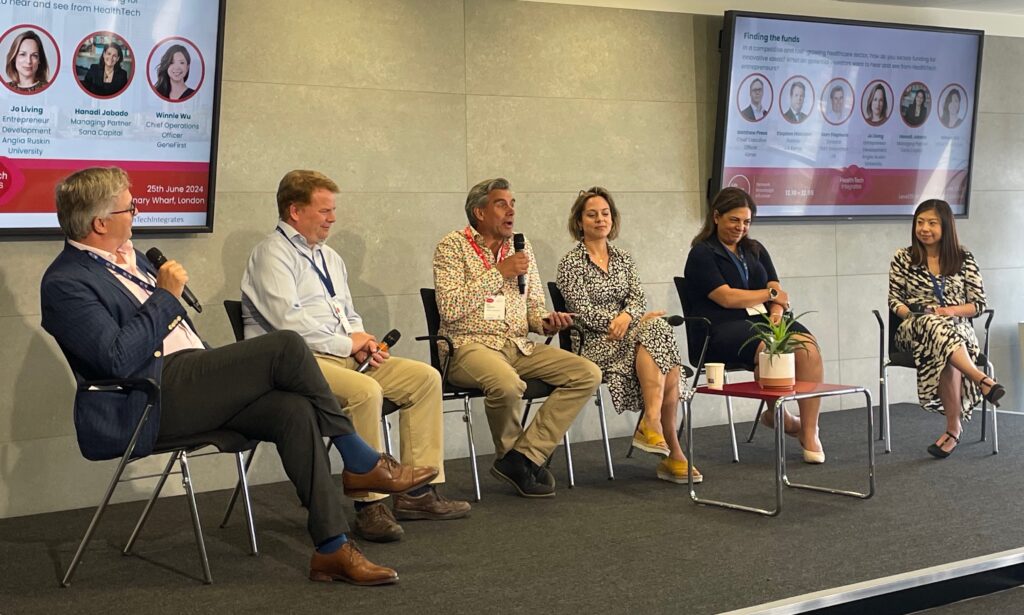
Matthew Press, Kimal, Stephen Hodsdon, J A Kemp, Sam Stephens, TBAT Innovation Ltd, Jo Living, Anglia Ruskin University, Hanadi Jabado, Sana Capital & Winnie Wu, GeneFirst
Chaired by Matthew Press, CEO of Kimal, Finding the funds brought together a panel covering all bases of the investor and innovator view.
Following introductions Matthew started the panel by asking Jo Living, Entrepreneur Development from Anglia Ruskin University her three things to consider before starting a fundraise in her experience.
Jo said “First; planning your fundraise is important – acknowledge how long it will take and know what your run rate is, what your burn rate is, can you support yourself. Second; understand what investors are looking for, and thirdly; treat your fundraise as a sales funnel, know that rejection is part of the game and make it part of your game.
Stephen Hodsdon, Partner at J A Kemp, then spoke from his experience on working with entrepreneurs to show value before funds.
He said “One of the key things when you’ve started innovation is it’s hard to capture it. Investors have become more savvy and previously would invest on a whim, does it sound like a good idea. Now they’re looking at what do you have?” Specifically, he advised “what do you have as a startup – you have an idea and a team. On the idea side how do you crystalise the idea and capture it in a way that makes it unique to everyone else. This is where IP strategy comes in. For every start up the advice will always be different depending on who your competitors are. The strategy in the early stage must look at two, three, ten years’ time and answer the question ‘what have you got’ and protects other people taking this.”
Asked about the different funding opportunities available, Sam Stephens, Director of TBAT Innovation, elaborated on the options. He said “In friends and family round make sure you get the legal right from the beginning. Make sure you are clean as a whistle. Tax schemes derisks it for the investor, what can you plan before you go looking for funding. Innovate UK is hard, but it is free money and it is a big flag in the ground. It shows you have gone through a rigorous and competitive process. Patent box – only 1500 companies claim, and it will half your tax bill. The UK is great place to fundraise, but you must plan.”
With a unique perspective from both sides of the fence, Hanadi Jabado Managing Partner of Sana Capital started by warning “raising money is a full-time job. It is distraction from trying to build a business, build a product, and find customers. Equity from venture capital and angel is not for everyone. If you want to run your company forever this not for you”. She spoke about the importance of finding the right investor for your company, “Work out your end game and work out their timeframe. Most of the time this won’t line up. When looking at investors, add looking at how far they in the lifetime of their fund.” She added “It’s harder to get divorced than married. They will do due diligence on you so do it on them. Look at when they’ve gone wrong, how have they behaved.” On alternative funding, Hanadi said “Grant money is great but do not become grant junkie – go and play with the big boys and girls and get equity. An option is an Innovate UK loan but know that this is a business case not a grant case. They want a business case.”
Elaborating on the Innovate UK loans Sam said “get yourself on a finance course – you need to understand every penny in your model.”
Bringing a close to the panel, Winnie Wu, Chief Operations Officer at GeneFirst, gave her three takeaways of the financing journey. “Moving from corporate to startup was very different and interesting, Start with the end in mind and knowing your target market. Who is going to buy it and how are you going to get your product there. As entrepreneurs you see a healthcare challenge, IP to protect, turning an idea tangible – you might not think who is going to buy it, find out what the pain points are and have contingency for unexpected challenges. Second think about your clinical evidence piece – demonstrate that there is a need even in the early stage. Thirdly, be aware that non-diluted grant funding sources is for the funding to advance tech readiness level. It’s about demonstrating tech is sound and works and can turn into the product. It doesn’t fund business development – after funding you’re asked to show commercial strategy and you have a ‘so what period’ where you must plan how to take your commercialisation further.”
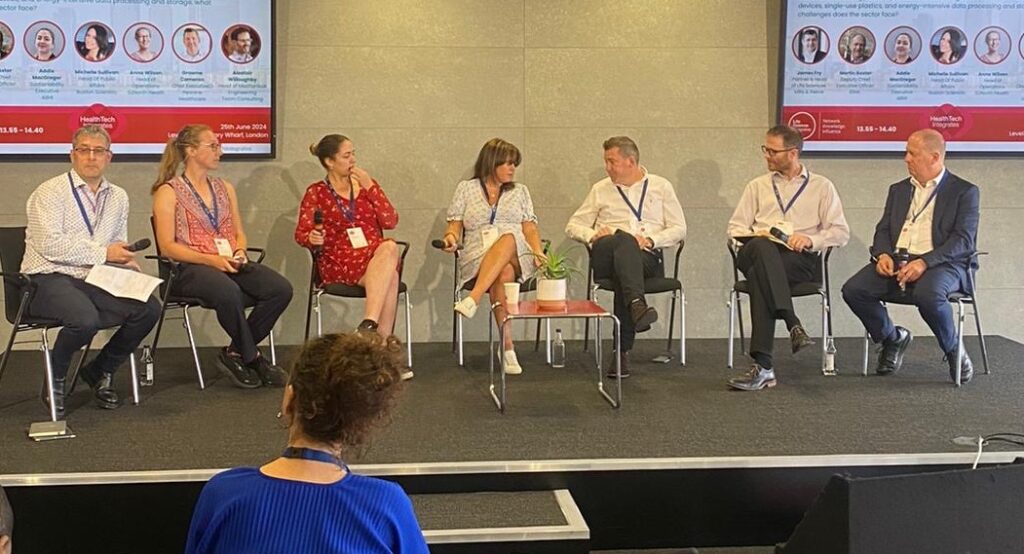
James Fry, Mills & Reeve, Anna Wilson, 52North Health, Addie MacGregor, ABHI, Michelle Sullivan, Boston Scientific, Graeme Cameron, Pennine Healthcare, Alastair Willoughby, Team Consulting & Martin Baxter, IEMA
“Environmental, social and governance standards feature heavily when we survey our clients about what keeps them up at night”.
James Fry, Partner and Head of Life Sciences at Mills & Reeve; and chair of the ‘Is HealthTech green tech?’ panel, began by outlining the importance of talking and thinking about sustainability in business and asked the panellists to introduce themselves and their sustainability journeys.
Graeme Cameron, CEO of Pennine Healthcare, began by outlining the one of the core challenges for them was having the knowledge in the business to deal with the challenge. “We didn’t have the data to understand what our carbon footprint.” He spoke about the importance of leading through purpose and shared value and the journey that Pennine Healthcare went on to embed a culture of sustainability. He shared his three goals starting that journey and how it went. “We needed to; educate colleagues on how we can get there and why it’s important, we were keen to eliminate waste and we needed to generate data. We worked with third parties to achieve these goals, a lot of hard work but starting to change the business and change the culture.”
Michelle Sullivan also gave her journey as Head of Public Affairs at Boston Scientific. She said “Boston Scientific started on this journey in 2011, when our leader said we need to start electrifying and reducing emissions. Scope 1 and 2 (everything you’re in charge of) is reaching net zero for those scopes. Med Tech is realising what a challenge Scope 3 is, a lot is out of your control and a lot of emissions are sitting outside of your control. You have to pay attention to it now, otherwise you’re going to get left behind. There are areas where you have to collaborate. If you do this strategically it has a massive impact. You’ve got to pick the right solutions for the right challenges. I think of it as dominoes, once you start knocking over the first one, the rest will follow.”
James then asked the panel about the challenges to come. Addie Macgregor, Sustainability Manager at the ABHI, started positively, “it’s promising in where we’ve come in the last 3 years. Sustainability is now a board level conversation because of the NHS demand for reduction. Where we need to get to is quite hard but we’re going in the right direction, if we keep going at this pace we’ll get there.”
Alastair Willoughby, Head of Mechanical Engineering at Team Consulting, spoke about how despite sustainability being embedded into the devices being designed now there is a legacy issue. “A huge number of legacy products out there that have not been designed with sustainability in mind. We need a real push through life cycle management to improve those products that are already out there”
Martin Baxter, Deputy Chief Executive Officer at the IEMA, elaborated on the challenges from a government perspective. He said “many organisations are setting longer term targets; they have an ambition but don’t know how they’re going to get there. Translating ambition into action is the challenge.” On the specifics, he said “As companies develop, transition plans need to be more granular on what they need to do to avoid a credibility gap. This gap will be exposed with new measurements coming down the line. Companies with a credible plan are getting better rates on loans from major banks, and money talks!”
On what needs to happen to address the challenges in hitting sustainability targets Alastair said “We’re now seeing genuine collaboration between companies and that’s what is needed. But how much are we willing to pay extra for sustainability, there needs to be a better cost than existing solution and it is difficult to drive cost down.”
Anna Wilson, Head of Operations at 52North Health added “purchasers making decisions having a cost of carbon would help. Thinking about the holistic impact of the product would help too, think about the carbon footprint of the whole system.”
Michelle agreed saying, “the biggest problem is that nobody understands what this is and how serious this is. We’ve got to take more personal responsibility; more individuals need to advocate within companies.”
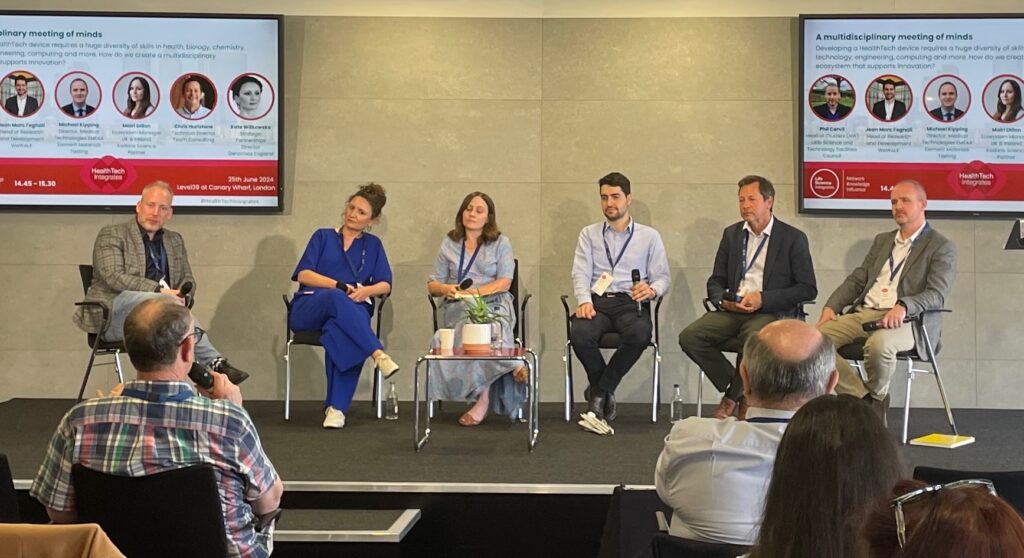
Phil Carvil, UKRI STFC, Kate Witkowska, Genomics England, Mairi Dillon, Kadans Science Partner, Jean Marc Feghali, WeWALK, Chris Hurlstone, Team Consulting & Michael Kipping, Element Material Testing
Chaired by Phil Carvil, Head of Clusters (NW) at the UKRI Science and Technology Facilities Council, A multidisciplinary meeting of minds brought together a diverse panel from across the Health Tech Sector.
The first discussion of the panel focussed on understanding what we mean by multidisciplinary. On the distinctions between Multidisciplinary and interdisciplinary the panel spoke on the agreeing on the definitions.
Kate Witkowska, Strategic Partnerships Director at Genomics England, said “The NHS arm of Genomics England is now generating data that can be studied and used in lots of different way. Multidisciplinary runs in my DNA.”
Mairi Dillion, Ecosystem Manager UK & Ireland at Kadans Science Partner, spoke from her experience managing a community of tenant and enabling collaboration and said, “my role is supporting our tenants in succeeding, multidisciplinary connection is fundamental.”
Jean Marc Feghali, Head of Research and Development at WeWalk, spoke about how links to the UKRI have enabled WeWalk to connect with academic institutions. He said “they’re experts in computer vision – but they never would have worked with visually impaired person. This brings together two separate worlds who never would have interacted, but everyone wants to build a project that will work but each have different experiences that they can bring to the table.”
The panellists were then asked to list who they thought would be key to have on a multidisciplinary team. Chris Hurlstone, Technical Director at Team Consulting said “Setting of on the journey you need to ensure you have all the right inputs. Have the right product inputs from users, understand the requirements and restraints, how will it be used.”
From the perspective of developing a mobility aid Jean Marc said “advocates; people on the ground, the secondary carers – when we started working directly working with them, they were the gate keepers and people saw the value in it and can help develop it.”
Michael Kipping, Director, Medical Technologies EMEAA at Element Materials Testing, said “someone with regulatory skills but it depends on your stage. There’s lots of topics you have to deal with as an innovator and its knowing when you need to know about what. One of the challenges for innovators is understanding who to go to and when to go to them.”
The conversation then moved on to how can funding bodies and others facilitate these multidiscipline teams. Michael spoke about the success of the pandemic response and attributed that to clarity from the NHS about what they needed. “Set a target profile – what is the minimum viable product? What does safety look like and how do you test the products. After that you have a clear procurement pathway, in the pandemic everyone pitched in. Most ventilators that were made were old, but some were new. When all the stars align it is possible to do amazing things in a short amount of time. You can’t have that focus all the time but what can we put in place so that we can set expectations for the next health challenge.”
Chris added “There was a common goal and people worked incredibly quickly, the response to ‘we need these, and we need these really quickly’ was that there was trust and flexibility. However, the downside to this approach is that there is a lot more waste.”
Kate agreed and emphasised “recognise what is in your ecosystem. Have infrastructure that is ready to plug and play. Where covid was transformational we tapped into our playbook and people worked together to enable that ecosystem.”
On the topic of enabling these ecosystems Mairi said “embedding regional ecosystems is core to what Kadans do. We choose locations carefully, build the location, and having peers, innovators, regulators etc around you is so important. Water cooler moments. Lots of collaboration and physical meeting of people – this imprints trust. With existing ecosystems, we can tap into these advantages. Innovation is about grey spaces and as property developers we have the ability to thread the golden threads and bring people behind a challenge and encourage people to show up and face a challenge together”
Jean Marc spoke about the challenge at the moment in building these teams. He said “the biggest challenge is funding. You have to choose the right region and the right ecosystem. In the UK there’s no excuse because there’s a lot of pots of funding that fund partnerships.”
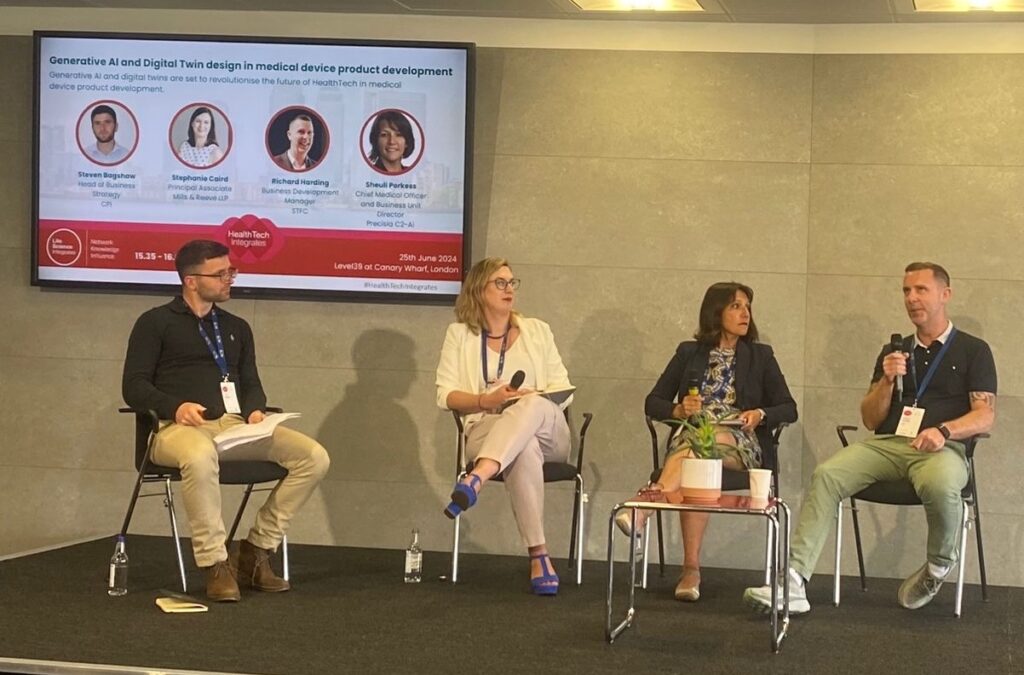
Steven Bagshaw, CPI, Stephanie Caird, Mills & Reeve, Sheuli Porkess, Precisia C2-Ai & Richard Harding, STFC
The final panel of the day ‘Generative AI and digital twin design in medical device product development’ explored the current and future impact of AI in health tech. Chair, Steven Bagshaw (Head of Business Strategy at CPI) began the session asking panellists how AI is currently disrupting in healthcare.
Richard Harding, Business Development Manager at STFC, said “the large language model has been amazing to see how that is disrupting. We’ve seen the explosion of this, but there is a lack of understanding of what these things do. The guardrails are still needed round the edge”
Sheuli Porkiss, Chief Medical Officer and Business Unit Director at Precisia C2-Ai, added “where it gets exciting is where is combines across multiple areas. What does ai actually mean, people are trying lots of things and in a year, we’ll be able to see where it works well.”
Steven then asked the panel about digital twins and about their potential uses in medicine. Richard answered, “If you decide that that’s where you want to go a possible use may be in an area where simulating it might be useful, but the stepping stones are modelling the data and making a link between the real world so that you can actually do something useful.”
Stephanie Caird, Principal Associate at Mills & Reeve said, “if you look at greys anatomy, they practice procedures on a simulated model to see what the outcomes are if you do things differently – I always envision it as something like that as a visual representation of how that might be useful.”
The panellists however spoke on the risks of using new technology. Sheuli cautioned “You need to know what you’re actually trying to do with the digital twin and then see how to build a twin that effectively does that.”
Richard agreed and said “you might have really good quality data but the model you apply might not be applicable. Digital Twin is a buzz word. The accuracy of the model you are using is very important.”
Steven then asked the panel about how they see the use of AI in moving towards personalised preventative medicine. Stephanie said “On a patient level, what do they want out of it. It could be used to determine a healthcare systems approach, could we use virtual wards where we create a log of that patient so that they can continue getting their treatment at home using equipment they already have. We could use it in the development of devices, looking to personalise the device to a patient rather than a general device fitted in a patient.”
Moving to the challenges of AI in healthcare however she said “Personalised devices opens a can of worms within regulation. How far do you take it on a patient by patient basis?”
Richard also discussed that it will be key for AI in healthcare to be trustworthy, transparent and ethical, “not black boxes that we don’t understand”. He encouraged innovators to focus and to “Move away from shiny stuff and back to the problem you’re trying to solve. People, process, digital.”
Stephanie referred back to some of the current issues with AI in HealthTech devices and said “the black box problem is that you have an AI model, but if you don’t know how the results have been reached – how do you fix the problems? From there you can stray into the legal issues. Another issue is device regulation as there are no rules on how that’s regulated at the moment. We have not worked out the conflict points between different regulations.”
Sheuli also highlighted the need for equity in medical devices. She spoke about a whitehead review on preventing bias in medical devices and specifically spoke about issues with diversity of data and transparency.
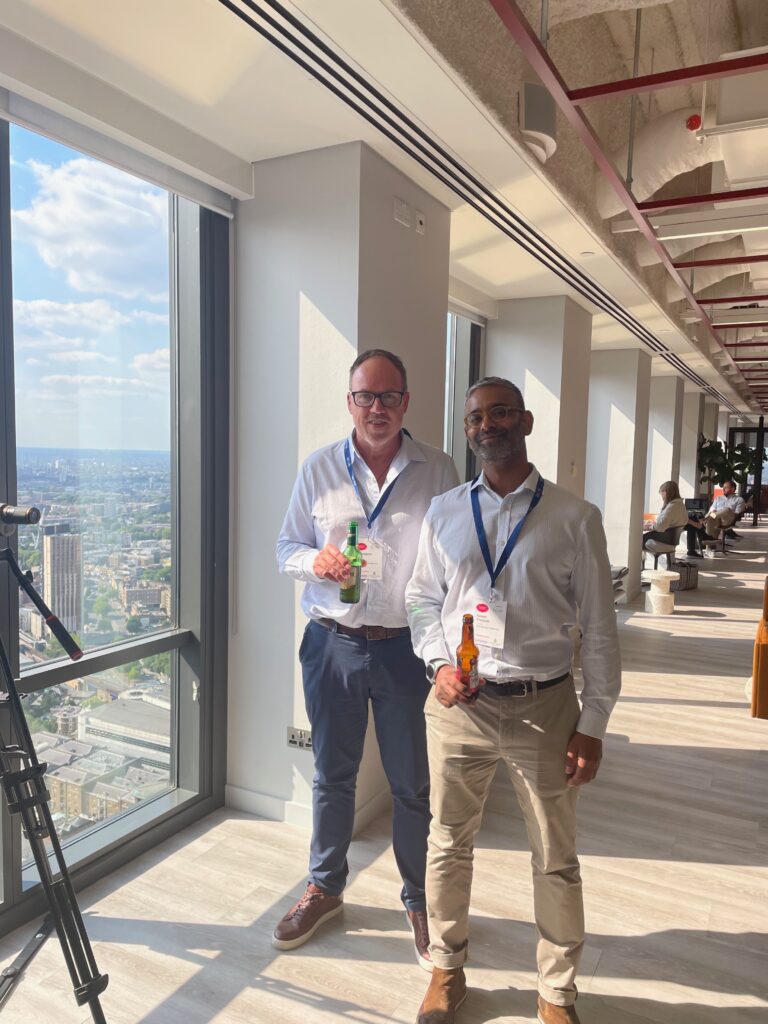
HealthTech Integrates 2024 brought together leading minds from across the HealthTech sector for insightful panels discussing key topics from; sustainability, the role of AI, funding and multidisciplinary approaches, all underscored the importance of collaborative efforts in driving innovation within the industry and the support needed from industry partners, regulators and funders to make that happen.
Samuel Thangiah, Co-Founder & Executive Director of Life Science Integrates said: “All day we’ve had insightful discussions that have shown that HealthTech is a very exciting industry right now, a feeling that has been palpable all day from the attendees and speakers. To get to work with Canary Wharf Group and Kadans Science Partner to bring the right people into a room together, in a wonderful venue, who are actively setting the stage for future innovations is great and we’re looking forward to having everybody back next year”
Christopher Watt and Samuel Thangiah,
Co-Founders and Directors of Life Science Integrates
Christopher Watt, Co-Founder & Executive Director, Life Science Integrates added, “Today’s event has been a resounding success, and we are proud to have facilitated an event that will drive the Health Tech sector forward. Thank you to our hosts, sponsors, partners, speakers and attendees who have made this event possible”.
